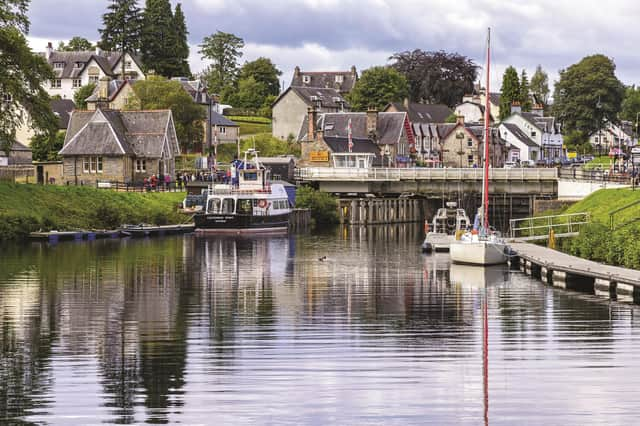Area focus: Fort Augustus


Starting at the riverside in the city’s Bught Park, the route follows Loch Ness, passing the quaint villages of Abriachan and Drumnadrochit, before heading towards the settlement of Fort Augustus, after which it loops back to Inverness.
For property buyers who are lovers of the great outdoors, the event provides the perfect opportunity to scout out some of the impressive residential locations around the serene water.
Advertisement
Hide AdAdvertisement
Hide AdOn the loch’s southern tip – and a landmark on the 73-mile Great Glen Way – Fort Augustus is a picture-postcard Highland destination that is home to some 640 people.
The settlement was originally called Kilchuimen after Saint Cummein of Iona, who built a church there.
According to Fort Augustus’ Highland Club, the village was the middle point of the great Glen of Albyn with the distinction of having the only roads in that part of Scotland during the 18th Century.
It was therefore a suitable place on which to build a barracks in 1716. A bigger and more impressive alternative was completed in 1729 on the peninsula between the rivers Oich and Tarff, by General Wade, who – having seen off the Jacobite rising of 1715 – had grand if somewhat immodest plans for a town named Wadesburgh to spring up around the fort.
Instead, it was named after Prince William Augustus, Duke – or Butcher – of Cumberland who smashed the Jacobite forces in the Battle of Culloden and, ultimately, destroyed the Scottish clan system.
The remains of the building that gave the town its name have since been incorporated into St Benedict’s Abbey, later used as a school and now home to The Highland Club’s luxury apartments.
But Fort Augustus is best known for its series of water locks and its picturesque position on the point where the two rivers and the Caledonian Canal enter Loch Ness.
Its stunning beauty attracts more than 300,000 visitors a year and, just an hour’s drive south of Inverness, you can see the appeal of swapping the city for a rural Highland retreat on a permanent basis.
Advertisement
Hide AdAdvertisement
Hide AdHomes there are in demand – the average value of a property is £239,967, states Zoopla, a value increase of £16,886 in the last year.
There is a wide variety of property types available in and around the centre of Fort Augustus, from large detached villas to stone and whitewashed cottages.
Arguably the most scenic spot is Canal Side, which features many spectacular detached stone-built homes with the man-made waterway and its lock system right on their doorsteps. A property at this desirable address will cost about £250,000.
To the north of the settlement is The Riggs, where properties have a more affordable price tag, averaging about £100,400. The cul-de-sac features terraced houses and semi-detached cottages, which boast large gardens and ample parking.
South of Fort Augustus is a similar development around Abertarff Place, and prices here are roughly the same as at The Riggs.
The nearby Great Glen Way has a series of idyllic cottages and leads to Church Road and Jenkins Park, which features spacious, individually-designed properties with dramatic hilltop views.
Perhaps the most sought after address is the iconic Highland Club, set within 20-acre grounds. A two-bedroom penthouse apartment there will cost at least £475,000, but with on-site facilities including a swimming pool, tennis court and spa, it is a worthy price tag.
While there are no major supermarket outlets, there is a Londis and many lovely independent boutiques and cafés.
Advertisement
Hide AdAdvertisement
Hide AdWhether it is time for a change of location, or to buy a holiday home set in some of Scotland’s most spectacular countryside, Fort Augustus should be at the top of the list of places to check out.
Average market value of a property in the area (Source: Zoopla)
Detached house £308,343
Semi-detached £188,283
Terraced £180,772
Flat £248,186
Attractions
The Loch Ness Viewpoint is a must-see vantage point, even if you are not on the keen look out for you-know-who. Handy for Fort Augustus, it sits on the peninsula between the rivers Oich and Tarff on the southernmost tip of Loch Ness. There is also a small beach nearby for dipping toes in the serene waters.
The Caledonian Canal Centre at Canal Side unlocks the settlement’s heritage, telling the story of the importance of the Caledonian Canal, the Great Glen and Loch Ness. The attraction is open all year and has a café serving locally-sourced produce and artisan ice cream from the Black Isle Dairy. Visitors are welcome from Monday to Friday, 9am to 5pm.
The Clansman Centre is just a few metres down the road on Canal Side, housed in the community’s former Old Schoolhouse, built in the 19th-Century. It features a recreation of a 17th-century Highland turf house, pictured, and a small theatre which stages shows dedicated to the clans’ way of life. There is also a shop selling Celtic, Scottish and locally-produced crafts. It is open from March to October between 10.30am and 5pm on weekdays, except Tuesdays and Wednesdays.
Urquhart Castle is a short drive away on the northern shore of Loch Ness. The ruins of today belie the fact that this was once Scotland’s largest castle. It saw great conflict between the 13th and 16th centuries, before British troops blew it up during the Jacobite Risings. Nowadays it has a deeply impressive visitor centre and is open daily between 9.30am and 6pm.